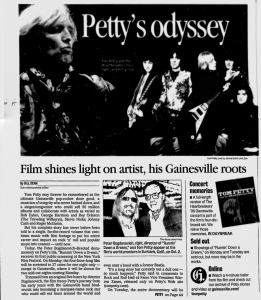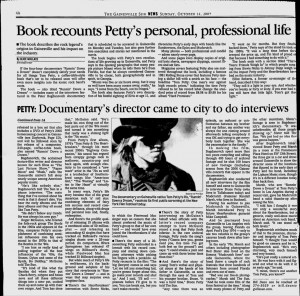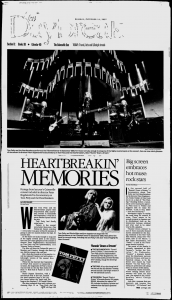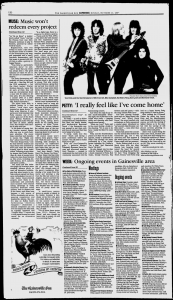Editor's Note: The fourth article in the scan ("Big Screen Embraces...") can be read here.
Petty's odyssey: Film shines light on artist, his Gainesville roots
By Bill Dean
Gainesville Sun - Sunday, October 14, 2007
PETTY: Documentary's director came to city to do interviews
Tom Petty may forever be remembered as the ultimate Gainesville pop-rocker done good, a musician of integrity who never backed down, and a singer/songwriter who could sell 50 million albums and collaborate with artists as varied as Bob Dylan, George Harrison, and Roy Orbison (the Traveling Wilburys), Stevie Nicks, Johnny Cash and Roger McGuinn.
But his complete story has never before been told in a single, for-the-record volume that combines music with film footage to put his entire career and impact on rock 'n' roll and popular music into context -- until now.
Today, the Peter Bogdanovich-directed documentary on Petty's life, "Runnin' Down a Dream," receives its first public screening at the New York Film Festival. On Monday, the four-hour-long film will be screened in 27 cities for one night only -- except in Gainesville, where it will be shown for two sold-out nights starting Monday.
Trimmed from an original five hours by director Bogdanovich, the film traces Petty's journey from his early years with the Gainesville band Mudcrutch into becoming a marquee-name rock star who could sell out tours around the world and even start a band with a former Beatle.
"It's a long story but certainly not a dull one -- so much happens," Petty said in comments to Rock and Roll Hall of Fame Vice President Warren Zanes, released only on Petty's Web site (tompetty.com).
On Tuesday, the entire documentary will be released in a box set that also includes a DVD of Petty's 2006 homecoming concert in Gainesville (see Daybreak, page 1D), and will be followed soon by the release of a companion, 240-page, coffee-table book, also named "Runnin' Down a Dream."
Bogdanovich, the acclaimed feature-film writer and director known for such films as "The Last Picture Show," "Paper Moon" and "Mask," calls the Gainesville native's full story nearly unique among American popular music.
"He's like nobody else," Bogdanovich told The Sun in a phone interview. "The main thing that I've noticed about his work is that it doesn't date. You hear the early albums and the later albums and they all sound like Tom Petty.
"He didn't follow any trends. He was always his own guy."
Roger McGuinn, who fronted the folk-rock group The Byrds in the 1960s and appears in the film, compares Petty's accomplishment of combining seminal influences into his own sound in the 1970s to that of the Beatles in the '60s.
"I see him as really kind of pulling together all the best influences of the '60s: the Stones, Dylan, and some of the Byrds, Bo Diddley," McGuinn told The Sun.
"It's kind of like what the Beatles did when they put Chuck Berry, calypso and bossa nova and all these different things into a stew pot, cooked them up and came up with their own recipe. And Tom has done that," McGuinn said. "He's made his own thing out of the besst parts ouf the '60s music and turned it into something that really was a shining light into '70s music."
From Petty's first album, 1976's "Tom Petty & The Heartbreakers," through his most recent 2006's "Highway Companion," his sound has segued from scrappy garage rock to mellower, acoustic-pop and back again, with enough elasticity to be considered a "new wave" artist in the '70s as well as a troubadour of Southern-bred songs like "American Girl," "The Waiting," and "Listen to Her Heart" at virtually the same time.
In many ways, Petty's life story became that of the great American rock 'n' roll star: combining elements of fairy tale success and record company defiance, along with drugs and personal loss and finally, redemption.
And there's the prolific quality of releasing 15 albums with a combined sales of 50 million-plus -- and releasing an astounding 42 singles that have tracked on Billboard's various singles charts over a 25-year period. (In comparison, Bruce Springsteen has released 47 songs on Billboard's charts, while Fleetwood Mac has tracked 35 Billboard singles).
But while much of Petty's life is well-known, it's the background and subplots of his story that reverberate in "Runnin' Down a Dream" -- and in ways that may surprise even longtime fans.
- There's the Heartbreakers' interaction with Stevie Nicks, in which the Fleetwood Mac singer says on camera that she almost preferred the music of Petty's group to her own band -- and would have even joined the Heartbreakers if she could have.
- There's the story of a 20-something Petty embroiled in a lawsuit with his record company and staring down company attorneys while picking his fingers with a penknife. As Petty recounts in the film: "The big (lawyer) comes in and says 'Let me tell you something kid, you're gonna forget about this, go make your records and shut up.' And I said, 'I'll sell ------ peanuts before I'll give in to you. You can break me, but you can't make records.'"
- There's the story of Petty intervening on McGuinn's behalf when officials with the latter's record company attempt to have McGuinn record a song that Petty finds inferior. In the rare archival footage, Petty reads the songs lyrics ("Gonna love you, gonna need you, this time I've got both feet on the ground") and says: "I could smoke a joint and come up with three better lines than that."
And there's the story of young Tom's verbal and physical abuse at the hands of his father in Gainesville, as soon through the eyes of Tom and his younger brother, Bruce. "It was a hard time," Bruce Petty told The Sun.
"Any time there was an episode, an outburst or confrontation between my brother and my father, my mother was always the one coming around afterwards telling everybody it was OK and trying to get everybody back together. She was the peacemaker in the family."
In making the film, Bogdanovich spent more than two years compiling and sifting through 400 hours of archival footage and he shot 100 hours of new footage (including scenes from the 2006 Gainesville concert) that appear in the documentary.
Bogdanovich also conducted all new interviews for the film himself and came to Gainesville to interview Bruce Petty (who lives in Tallahassee today) and Mudcrutch drummer Randall Marsh who lives in Bushnell.
During his audition to join Mudcrutch in Gainesville, Marsh introduced Petty to future Heartbreakers guitarist Mike Campbell.
And he journeyed from Gainesville to Los Angeles with the group, leaving Florida on April Fool's Day 1974 -- only to see two vehicles in the group's caravan break down after leaving town.
In the early '70s, Marsh and others including photographer Red Slater also lived on the famous "Mudcrutch farm" outside Gainesville, where the band threw a couple of rock festivals that drew hundreds of listeners from around Florida and even out of state.
"Red was out live-in photographer," Marsh told The Sun. "And he took some film of the farm festival at the time." Along with many photos of Petty, and the other musicians, Slater's footage is seen in Bogdanovich's documentary. "It was unbelievable; all those people showing up," Slater told The Sun. "We had no idea that was gonna happen."
After Bogdanovich interviewed Bruce Petty and Marsh (in a room at the Paramount Plaza Hotel on SW 13th Street), the three got in a car and drove around Gainesville to show the director some of the locations that figured in the early day of Petty and his band, including the Lipham music store, though it's in a different location today than back then.
Marsh, who saw "Runnin' Down a Dream" at Tom Petty's home in Los Angeles during a recent visit, gave his Mudcrutch band a solid thumbs-up after seeing the film.
"I told him I thought it was not only a wonderful story about the Heartbreakers, but a generic, really well-done movie about an American rock band," Marsh said. "It can stand on both levels."
Bogdanovich attributes much of that to the presence, character and integrity of Tom Petty himself. "I thought Tom would be good on camera and he is," Bogdanovich said. "He's very charming, very much himself and very honest.
"He's just really a natural artist. He was born with it and figured out what to do with it at an early age," he said.
"I mean, there's not another Tom Petty, you know?"
Book recounts Petty's personal, professional life
By Alice Wallace
Gainesville Sun - Sunday, October 14, 2007
This book describes the rock legend's origins in Gainesville and his impact on the industry.
If the four-hour documentary "Runnin' Down a Dream" doesn't completely satisfy your needs for all things Tom Petty, a coffee-table-style book that's set to be released soon will offer even more insights into the iconic rock band's roots.
The book -- also titled "Runnin' Down a Dream" -- includes many of the interviews featured in the Peter Bogdanovich documentary that is scheduled to be screened in Gainesville on Monday and Tuesday, but also goes further into anecdotes and stories not mentioned in the movie.
The book begins with Petty's own recollections of life growing up in Gainesville, and Petty says in the opening paragraphs that many people picture Miami when he tells them he's from Florida, but that he always considered Gainesville to be closer, both geographucally and in spirit, to Georgia.
"Miami was five or six hours away, but it may as well have been many oceans away, really," he sayd. "I come from the South, not its fringes."
The book also features Petty's own description of his fateful sighting of Elvis at age 11, and chronicles Petty's early days with bands like the Sundowners, the Epics, and Mudcrutch.
Many photos -- both professional and candid -- adorn nearly every page.
And some pages even display copies of original lyric sheets, newspaper clippings, concert fliers and set lists.
Magazine covers featuring Petty also are scattered throughout the book, including a famous 1981 Rolling Stone cover that features Petty tearing a dollar bill with a smirk on his face -- the headline "Tom Petty: One man's war against high records prices," indicating the time Petty refused to let his record label change the standard price of record from $8.98 to $9.98 for his album "Hard Promises."
"It went on for months. But they finally backed down," Petty says of the stand he took in the 1980s. "It was a long time before they creeped the price up, and I'm kind of proud of that because I had something to do with it."
The book ends with a section titled "Thirty Years: Friends Weigh In" in which people ranging from Stevie Nicks to Johnny Depp weigh in on the impact Petty and the Heartbreakers have had on the music industry.
Elliot Roberts, a former co-manager of the band, described it this way:
"They call it a light in your eye. And whether you're twenty or forty or sixty, if you ever had it, you still have that little light. Tom's got that light."
Heartbreakin' Memories
By Alice Wallace
Gainesville Sun - Sunday, October 14, 2007
Footage from last year's Gainesville concert included in director Peter Bogdanovich's documentary on Tom Petty and the Heartbreakers
When Tom Petty and the Heartbreakers played their long-awaited 30th anniversary concert in Gainesville last September, it was like a warm blanket spread across the city.
Tom Petty had finally come home.
Tickets to the concert were hotter than even a Tim Tebow-led Gators matchup -- every ticket was gone within 30 minutes of going on sale two months before the Sept. 21 concert date.
So for those not lucky enough to snag one of the highly coveted spots at the concert, fans can now catch glimpses of the concert in director Peter Bogdanovich's documentary on Tom Petty and the Heartbreakers, titled "Runnin' Down a Dream."
The film will have its Gainesville premiere Monday and Tuesday, though the showings are, like the concert was, sold out.
But a four-disc boxed set of the movie also will be released Tuesday and will include a full-length version of the concert from start to finish.
When the day dawned last September on Petty's first concert in 13 years, the magnitude of Petty's return was not lost on the city that claims the Rock 'n' Roll Hall of Famer as one of its own.
Mayor Pegeen Hanrahan, with a star-struck look in her eye, handed the band members keys to the city just hours before the band took the stage at the Stephen C. O'Connell Center.
She also presented them with a plaque proclaiming September 21 as "Tom Petty and the Heartbreakers Day" in Gainesville.
For Petty -- as well as fellow Gainesville-bred Heartbreakers Ron Blair, the band's bassist, and keyboardist Benmont Tench -- the Gainesville concert seemed to suit them well, and they all expressed that they were happy to be home.
"I really, really love this town," Tench said during a news conference before the concert. "You all need to realize what you've got."
Even the non-Gainesville guys -- guitarist Michael Campbell, drummer Steve Ferrone, and all-around musician Scott Thurston -- seemed to understand the electricity in the community associated with the homecoming concert.
And when the stage lit up on that much-anticipated Thursday night, the 10,000 fans in the crowd were ready -- jumping wildly and cheering until their throats were hoarse.
"What can I say?" Petty said to the crowd during a break in the cheering. "It's so nice to be here. I really feel like I've come home."
Petty and the Heartbreakers played a set that was not to disappoint, mostly a mishmash of Petty's hits through the years punctuated by a few rockin' covers including Bo Diddley's "I'm a Man" and Fleetwood Mac's "Oh Well."
He also dipped into his days with the Traveling Wilburys -- a band composed of Petty, Bob Dylan, George Harrison, Roy Orbison and Jeff Lynne -- with the song "Handle with Care."
And after running through tunes such as "Mary Jane's Last Dance" and "Won't Back Down," the crowd swelled with enthusiasm as Petty announced a special guest, introduced as "an honorary Heartbreaker, our little sister" -- none other than Stevie Nicks.
Nicks had joined the concert tour for several dates before the Gainesville gig, but it was uncertain until that moment if she would grace the O'Connell Center stage with her presence.
Nicks, looking sleek in a jet-black dress with her long, blonde hair hanging loose, joined the band for several songs, including she and Petty's hit duet "Stop Draggin; My Heart Around," and Nicks sang lead on a lesser-known Petty song entitled "I Need to Know."
After rocking the O'Connell Center for about two hours, Petty and the Heartbreakers were lured back on stage for an encore, not with the waving of lighter flames as in the past, but with the waving of cell phone screams glowing in shades of blue and green.
And it was a good thing the band came back, because Petty's fans were still waiting for a Gainesville rendition of "American Girl," with its reference to listening to the "cars roll by out on 441, like waves crashing on the beach."
And the crowd got its wish.




